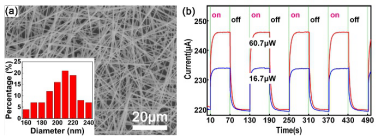
A Chinese research team led by Prof. FEI Guangtao from Institute of Solid State Physics, Hefei Institutes of Physical Science, Chinese Academy of Sciences, reported a facile route to synthesize uniform Te NWs in large quantity by a PVP-assisted solvothermal process under mild conditions, which was accepted as back cover image of Physical Chemistry Chemical Physics.
According to studies of these years, one-dimensional nanomaterials such as nanowires (NWs), nanorods, nanotubes have been intensively explored due to their fundamental interest and potential applications. Among them, as a narrow direct band gap semiconductor (0.35 eV), tellurium (Te) displays interesting optical properties.
Currently, considerable efforts have been made to synthesize the Te nanomaterials by solution-based approaches, however, which have drawbacks such as the hazardous chemicals (such as NaBH4, NH2OH, N2H4·H2O and (NH4)2 S2) as reducing agents and extreme operating conditions.
Low-temperature green chemical synthesis in aqueous solution is highly desirable because it is an environmentally benign and user-friendly approach, which may be considered to be a relatively practical alternative for industrialization.
It has been shown that most advantageous nanodevice configuration requires either a single or a few NWs running parallel to build up a well-defined conduction channel between two electrodes so that such properties can be easily modulated by external stimuli such as light illumination and magnetic field.
Oil-water interfacial self-assembly is a powerful bottom-up approach for arranging most low-dimensional nanostructures in ordered array. This assembly strategy effectively opens the door for the self-assembly of hydrophilic nanostructures into closely-packed nanofilms.
In their work, the SEM image of the Te nanowires and the diameter distribute of the nanowires are shown in Figure 1(a). Then assembled the Te NWs into ordered alignment through stirring-assisted assembling method.
After that, photodetectors based on well aligned Te NWs film were fabricated.Time dependent photocurrent response to 980 nm pulsed incident light with a period of 60 s under 77 K and bias voltages of 1.0 V. The responsivity can reach 86.52 A/W at bias voltage of 1.0 V.
The photodetector based on the well aligned Te NWs film had a series of more excellent photoelectric properties than that being randomly oriented. For example, the photoresponsivity of the forward is 103 times larger, and the response time is 1.15×103 times shorter than the latter.
The study is sponsored by National Basic Research Program of China (973 Program), the National Natural Science Foundation of China, the CAS/SAFEA International Partnership Program for Creative Research Teams, and the Foundation of Director of Institute of Solid State Physics, Chinese Academy of Sciences.

Figure 1. (a) SEM image of as-prepared Te Nanowires. Inset shows the diameter distribute of the product. (b) Time dependent photocurrent response to 980 nm pulsed incident light with a period of 60 s under 77 K and bias voltages of 1.0 V. (Image by ZHONG Binnian)

Figure 2. Back Cover Image of the Phys. Chem. Chem. Phys., 2016, 18(48). (Image by ZHONG Binnian)

86-10-68597521 (day)
86-10-68597289 (night)

86-10-68511095 (day)
86-10-68512458 (night)

cas_en@cas.cn

52 Sanlihe Rd., Xicheng District,
Beijing, China (100864)

